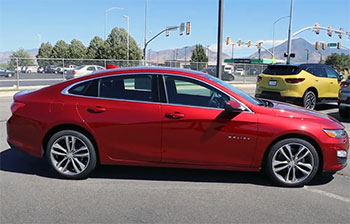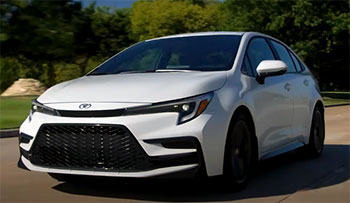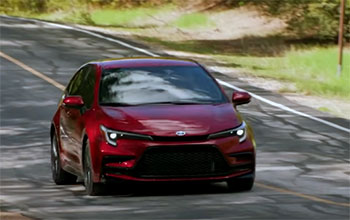When I set out to compare the Chevrolet Malibu and Toyota Corolla, my goal was to uncover which sedan best suits everyday drivers like you and me. As someone who’s logged countless hours behind the wheel, I wanted to explore their performance, comfort, reliability, and value to help you make an informed choice.
These two cars are popular for good reason, but they cater to slightly different needs. Below, I’ve laid out a detailed comparison table, followed by my personal experiences, pros and cons, and answers to common questions, all to guide you toward the right pick.
Chevrolet Malibu Vs. Toyota Corolla Comparison
| Feature | Chevrolet Malibu | Toyota Corolla |
|---|---|---|
| Starting MSRP | $26,995 | $23,520 |
| Fuel Economy (City/Highway) | 28/36 MPG | 32/41 MPG |
| Engine | 1.5L Turbo 4-cylinder (163 hp) | 2.0L 4-cylinder (169 hp) |
| Torque | 184 lb-ft | 151 lb-ft |
| Passenger Volume | 102.9 cu ft | 88.6 cu ft |
| Cargo Space | 15.7 cu ft | 13.1 cu ft (17.8 cu ft for hatchback) |
| Reliability Rating (J.D. Power) | 80/100 | 82/100 |
| Safety Rating (NHTSA) | 4.3/5 Stars | 5/5 Stars |
| Standard Safety Features | Basic (optional advanced features) | Toyota Safety Sense™ 2.0 |
| Warranty (Corrosion) | 6 years | 5 years |
| Maintenance Coverage | First visit free | 2 years/25,000 miles |
My Experience With the Chevrolet Malibu

Driving the Chevrolet Malibu feels like slipping into a comfortable, familiar jacket—one that’s stylish yet practical.
This midsize sedan has a sleek, aerodynamic look that turns heads without being overly flashy.
My first drive was on a mix of city streets and open highways, and the Malibu’s 1.5-liter turbocharged engine, delivering 163 horsepower and 184 lb-ft of torque, felt responsive, especially when merging onto freeways.
The low-end torque gave it a satisfying kick, making stoplight starts smooth and confident. I took it on a weekend trip with friends, and the 102.9 cubic feet of passenger volume was a godsend.
With 38.1 inches of rear legroom and 39.1 inches of front headroom, even my 6-foot-tall buddy didn’t complain about being cramped in the back. The cabin felt airy, almost luxurious for a car starting at $26,995.
The interior, while functional, had its highs and lows. The premium cloth seats in the LS trim were supportive for long drives, and the 6-speaker audio system handled my playlists decently, though it lacked the punch of premium systems in higher trims. The infotainment system, with an 8-inch touchscreen, Apple CarPlay, and Android Auto, was intuitive, but I found the interface a bit dated compared to competitors.
I also noticed the absence of standard advanced safety features like lane-keepingassist or adaptive cruise control, which required upgrading to the LT or Premier trims, pushing the price closer to $30,000. This felt like a drawback for a car in this segment, especially when rivals include these features at lower price points.
On the road, the Malibu’s suspension soaked up bumps well, making it a comfortable cruiser for highway stretches. I drove through a mix of smooth asphalt and pothole-riddled backroads, and the Malibu handled both with composure, though its larger turning radius (37 feet) made tight parking lots a bit of a challenge.
I managed to squeeze into a spot at a busy mall, but it took some extra maneuvering. The 15.7-cubic-foot trunk was a highlight, easily swallowing two large suitcases, a cooler, and my gym bag for a weekend getaway. Fuel economy, at 28 MPG city and 36 MPG highway, was decent but not stellar—I found myself refueling more often than I’d hoped during a week of mixed driving. The Midnight Edition’s 19-inch black wheels and sporty grille gave it a bold, racetrack-inspired look that I loved, but I couldn’t shake the feeling that the Malibu’s tech and reliability lagged behind competitors like the Corolla.
One memorable moment was driving the Malibu through a rainstorm. The standard stability control kept things steady, but I wished for standard lane-departure warnings, as the wet roads made me extra cautious. Overall, the Malibu feels like a car for those who prioritize space, style, and a refined ride, but it requires compromises in tech and long-term dependability.
My Experience With the Toyota Corolla

The Toyota Corolla, by contrast, feels like the reliable friend who’s always ready for anything—efficient, practical, and unassuming.
Its compact size (182.5 inches long, 11.9 inches shorter than the Malibu) made it a joy to zip through city traffic.
I took it on a series of urban errands—grocery runs, coffee shop stops, and navigating narrow downtown streets—and its tight 35.6-foot turning radius made parking a breeze.
The 2.0-liter 4-cylinder engine, producing 169 horsepower, felt peppy for a compact sedan, though its 151 lb-ft of torque meant it lacked the Malibu’s low-end punch.
Still, it handled acceleration well, especially in stop-and-go traffic, where I never felt underpowered.
The Corolla’s fuel economy—32 MPG city and 41 MPG highway—was a standout. During a week of driving, I saved noticeably at the pump compared to the Malibu, which was a relief with gas prices hovering around $4 per gallon. The interior, however, felt snugger with 88.6 cubic feet of passenger volume.
On a group outing, my rear passengers (one over 6 feet) complained about the 34.8 inches of rear legroom, and I could see why—long trips in the back weren’t as comfortable as in the Malibu. The front seats, especially in the XSE trim with SofTex upholstery, were supportive, and I appreciated the 7-inch driver display for its crisp, modern look.
The standard Toyota Safety Sense™ 2.0 suite was a game-changer. Features like pedestrian detection, lane-departure alert, and adaptive cruise control gave me confidence, especially during a late-night drive on a busy highway.
I recall a moment when the pre-collision system alerted me to a slowing car ahead, potentially preventing a fender-bender. The infotainment system, with Apple CarPlay, Android Auto, and SiriusXM (on higher trims), was user-friendly, though the base 7-inch touchscreen felt small compared to the Malibu’s 8-inch display.
The Corolla’s cargo space—13.1 cubic feet for the sedan—was adequate for daily needs but fell short of the Malibu’s cavernous trunk. I tested the hatchback version, which offers 17.8 cubic feet, which was a better fit for carrying my bike and camping gear.
On highways,“`the Corolla’s ride was smooth but noisier than the Malibu’s, with more wind and road noise creeping in at 70 mph. The SE trim’s 18-inch wheels added a sporty flair, but the overall design felt less bold than the Malibu’s. Toyota’s 2-year/25,000-mile maintenance plan and stellar reliability reputation (82/100 from J.D. Power) gave me peace of mind about long-term ownership. The Corolla is a car that prioritizes efficiency, safety, and dependability, though it sacrifices some space and power to achieve it.
Read More: My Thoughts On Acura MDX Vs. Volvo XC90
Pros Of the Chevrolet Malibu
- Spacious interior: The Malibu’s 102.9 cubic feet of passenger volume is a standout, offering ample room for families or groups. With 38.1 inches of rear legroom and 39.1 inches of front headroom, I found it ideal for long drives with friends, where everyone could stretch out comfortably without feeling squeezed.
- Generous cargo space: The 15.7-cubic-foot trunk is among the largest in its class, easily accommodating multiple suitcases, groceries, or sports equipment. I loaded it with two large duffels, a cooler, and shopping bags for a weekend trip, and there was still room to spare.
- Responsive torque: The 1.5-liter turbo engine’s 184 lb-ft of torque delivers quick, confident acceleration. I noticed this when merging onto highways or passing slower vehicles, where“`the Malibu outperformed the Corolla’s less torquey engine.
- Stylish design options: The Malibu’s exterior, especially the Midnight Edition with 19-inch black wheels and a blacked-out grille, has a sporty, premium vibe. I loved its racetrack-inspired look, which felt upscale for a non-luxury sedan.
- Comfortable ride quality: The suspension handles road imperfections well, providing a smooth, quiet ride on highways. During a 200-mile trip, I appreciated the minimal road noise and supportive seats, which kept fatigue at bay.
- Longer corrosion warranty: A 6-year corrosion warranty offers an extra year of protection compared to the Corolla’s 5 years. This was reassuring, especially for those in regions with harsh winters or coastal climates.
- Accessible dealer network: With over 4,000 Chevrolet dealers nationwide (compared to about 1,500 for Toyota), service and repairs are more convenient. I found this comforting, knowing I could find a dealership almost anywhere.
- Affordable customization: The Malibu offers packages like the Sport Edition, which adds black accents and wheels for under $1,000. I appreciated this flexibility to personalize the car without breaking the bank.
Cons Of the Chevrolet Malibu
- Higher starting price: At $26,995, the Malibu is $3,475 pricier than the Corolla. This gap was noticeable when I considered budget-friendly options, especially since advanced features require costly higher trims.
- Lower fuel economy: With 28/36 MPG (city/highway), the Malibu trails the Corolla’s 32/41 MPG. I refueled more frequently during a week of mixed driving, which added up with gas prices around $4 per gallon.
- Limited standard safety features: Unlike the Corolla, the Malibu doesn’t include advanced safety tech like lane-keeping assist or adaptive cruise control as standard. I had to upgrade to the LT trim, pushing the price closer to $30,000.
- Larger turning radius: The 37-foot turning radius made tight spaces challenging. I struggled in crowded parking lots, where the Corolla’s nimbler handling was a clear advantage.
- Lower reliability ratings: With a J.D. Power score of 80/100 and Consumer Reports ranking Chevrolet 20th in reliability, the Malibu lags behind the Corolla. I worried about potential repair costs over time.
- Mediocre resale value: The Malibu depreciates 43.7% over five years, compared to the Corolla’s 26.3%. This made me question its long-term financial sense, especially for those planning to sell later.
- Basic interior tech: The infotainment system, while functional, feels dated with a basic interface and no standard SiriusXM. I missed the Corolla’s modern touches, like the 7-inch driver display on higher trims.
- Slower tech adoption: The Malibu lacks standard features like wireless charging or a larger touchscreen, which are increasingly common in competitors. I felt it lagged in keeping up with modern expectations.
Pros Of the Toyota Corolla

- Superior fuel economy: The Corolla’s 32/41 MPG (city/highway) saved me significant money at the pump. During a week of driving, I went longer between fill-ups, a relief with gas prices near $4 per gallon.
- Standard safety suite: Toyota Safety Sense™ 2.0 includes pedestrian detection, lane-departure alert, and adaptive cruise control at no extra cost. I felt safer without needing to splurge, unlike with the Malibu.
- Higher reliability ratings: With an 82/100 J.D. Power score and Consumer Reports ranking Toyota second in reliability, the Corolla inspired confidence. I appreciated its reputation for fewer repairs.
- Better resale value: Retaining 73.7% of its value after five years, the Corolla outperforms the Malibu’s 56.3%. This made me feel better about its long-term investment potential.
- Lower starting price: At $23,520, the Corolla is more budget-friendly. I found this appealing for first-time buyers or those prioritizing value without sacrificing quality.
- Nimble handling: The compact size and 35.6-foot turning radius made urban driving a breeze. I easily navigated tight streets and parking garages, where the Malibu felt bulky.
- Versatile body styles: Available as a sedan or hatchback, the Corolla offers flexibility. The hatchback’s 17.8 cubic feet of cargo space was perfect for carrying my bike and camping gear.
- Free maintenance plan: The 2-year/25,000-mile maintenance coverage is a nice perk. I valued this for keeping early ownership costs low, unlike the Malibu’s single free visit.
Cons Of the Toyota Corolla
- Limited passenger space: The 88.6 cubic feet of passenger volume feels cramped, especially in the back with 34.8 inches of legroom. I noticed discomfort among taller passengers on longer trips.
- Smaller sedan trunk: The sedan’s 13.1-cubic-foot trunk is smaller than the Malibu’s. I struggled to fit larger items, though the hatchback’s 17.8 cubic feet helped.
- Lower torque: With 151 lb-ft of torque, the Corolla feels less punchy off the line than the Malibu’s 184 lb-ft. I noticed this during quick accelerations from stoplights.
- Basic exterior styling: While sporty in SE or XSE trims, the Corolla lacks the Malibu’s bold presence. I found it less eye-catching, especially in base models.
- Less interior volume: The compact classification means less overall space. I felt this most in the back, where passengers over 5’10” were noticeably less comfortable.
- Fewer dealer options: With about 1,500 Toyota dealers compared to Chevrolet’s 4,000, service access could be less convenient. I worried about longer drives for maintenance in rural areas.
- Noisy cabin at high speeds: On highways, I noticed more wind and road noise than in the Malibu, especially at 70 mph. This slightly detracted from long-distance comfort.
- Limited upscale options: The Corolla’s top trims lack the premium touches (like leather seats or larger wheels) available in the Malibu’s Premier trim. I missed that extra bit of luxury.
Read More: My Thoughts On Ford Escape Vs. Mazda CX-5
Frequently Asked Questions (FAQ)
The Chevy Malibu scores a decent 4.0/5 from RepairPal and 80/100 from from J.D. Power, but it trails the Toyota Corolla’s reliability. Consumer Reports ranks Chevrolet 20th, suggesting more potential issues over time compared to Toyota.
The Toyota Camry generally outperforms the Malibu with higher reliability (4.0/5 vs. 4.0/5 from RepairPal), better fuel economy (up to 51 MPG hybrid vs. 36 MPG), and standard safety features. The Malibu offers more passenger space (102.9 vs. 100.4 cu ft) and a lower starting price ($26,195 vs. $26,420). Choose the Camry for dependability and the Malibu for space.
The Malibu’s weaknesses include lower fuel economy (28/36 MPG), limited standard safety features, a larger turning radius, and weaker resale value (43.7% depreciation). Its reliability (80/100 J.D. Power) lags behind competitors like the Corolla.
The Malibu compares to midsize sedans like the Toyota Camry, Honda Accord, Hyundai Sonata, and Kia K5. It also competes with compact sedans like the Toyota Corolla, Honda Civic, and Nissan Sentra due to its price, though it offers more interior space.
Conclusion: For the Chevrolet Malibu and Toyota Corolla
After spending time with both the Chevrolet Malibu and Toyota Corolla, I’ve seen how they cater to different needs. You’ll love the Malibu if you prioritize a spacious, comfortable sedan with a sporty edge and don’t mind a higher starting price. Its roomy interior and responsive torque make it great for families or long drives. However, if fuel efficiency, reliability, and standard safety features are your priorities, the Corolla is tough to beat. Its lower price and better resale value make it a smart long-term choice. Test drive both to see which fits your lifestyle—you can’T go wrong, but your needs will decide the winner.

